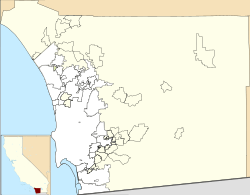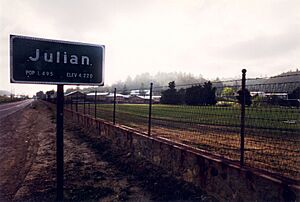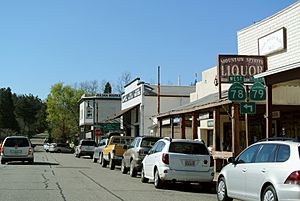Julian, California facts for kids
Quick facts for kids
Julian
|
||
|---|---|---|
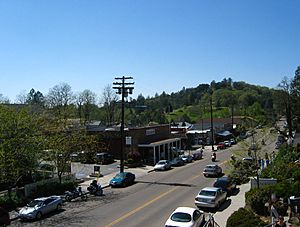
Main Street in Julian
|
||
|
||
| Motto(s):
"four seasons of beauty & fun..."
|
||
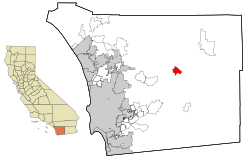
Location in San Diego County and the state of California
|
||
| Country | ||
| State | ||
| County | San Diego | |
| Named for | Mike Julian | |
| Area | ||
| • Total | 7.839 sq mi (20.303 km2) | |
| • Land | 7.839 sq mi (20.303 km2) | |
| • Water | 0 sq mi (0 km2) 0% | |
| Elevation | 4,226 ft (1,288 m) | |
| Population
(2020)
|
||
| • Total | 1,768 | |
| • Density | 225.54/sq mi (87.081/km2) | |
| Time zone | UTC-8 (PST) | |
| • Summer (DST) | UTC-7 (PDT) | |
| ZIP code |
92036
|
|
| Area codes | 442/760 | |
| FIPS code | 06-37582 | |
| GNIS feature ID | 1652732 | |
| Website | Julian Chamber of Commerce | |
| Reference #: | 412 | |
Julian is a small, charming town located in San Diego County, California. It's known for its beautiful mountain setting and its delicious apple pie. In 2020, about 1,768 people lived here.
Julian is recognized as an official California Historical Landmark. This means it's a special place with a lot of history. The town center is part of the Julian Historic District. This helps keep its old-fashioned look.
In 2021, Julian was named an International Dark Sky Community. This means the town works to reduce light pollution. It helps people see the stars clearly at night. Julian was the second place in California to get this special title.
The town is very famous for its apple pie. Every year, Julian hosts an Apple Days Festival. This tradition started way back in 1949!
Contents
History of Julian
Early Settlement and the Gold Rush
The first European settlers arrived in the Julian area around 1850. The town itself was founded in 1869 by the Bailey brothers and their cousins, Mike and Webb Julian. They were traveling through the area and loved its beauty. Drury Bailey decided to settle there and named the town "Julian" after his cousin Mike.
Soon after, gold was discovered in the Julian region. This led to a big gold rush! Many people rushed to the area hoping to find gold. At first, it was a "tent city" where people lived in tents. But as more gold was found, permanent buildings were built. Many of these were beautiful Victorian-style homes.
One important person was A.E. "Fred" Coleman, a former slave. In 1869, he found gold in a creek near Julian. This discovery helped start the gold rush. People quickly came to find more gold. On February 22, 1870, the first hard rock gold mine was started. It was named the Washington mine because it was George Washington's birthday.
While miners were busy digging for gold, a man named James Madison brought apple trees to the mountains. The trees grew very well in the cool, fresh air. Today, apples are still a huge part of Julian. Many are used to make the famous Julian apple pies!
In the early days, many Black people in San Diego County lived in Julian. They played a big part in the town's growth. For example, the Robinson Hotel was founded by Black residents. America Newton, a freed slave, was also a noted resident who helped miners.
Julian in the 20th Century
In 1976, Julian made a rule to protect its historic look. Buildings on Main Street had to look like they were built before 1913. This helped keep the town's old charm. By the 1970s, Julian was already a popular place for tourists. About 25,000 visitors came each year.
Julian's water supply has sometimes been a challenge. In the 1990s, during a dry period, the town faced water shortages. This made it difficult for new buildings to be constructed.
The Deer Lake Park & Julian Railroad
In the 1960s, a famous animator named Ollie Johnston bought and fixed up an old steam train. It was built in 1901 and named the Marie E. He built a special railroad track at his vacation home in Julian. He used old railroad ties from Disneyland's Viewliner train. The Marie E. first ran in 1968. Johnston sold the train in 1993, and it even ran one last time at Disneyland Railroad for a special event.
Julian in the 21st Century
Starting in 1999, the Julian area faced a long period of dry weather. This led to the huge Cedar Fire of 2003. This fire burned a lot of the land around Julian. Luckily, the main part of the town was saved.
Today, Julian is a popular mountain resort. Most businesses are for tourists, offering unique shops and places to eat. Many people from bigger cities like La Jolla own vacation homes here.
In 2017, the Julian Arts Guild opened a gallery in downtown Julian. It shows off the amazing artwork of local artists.
Geography and Climate
Julian covers about 7.8 square miles (20.3 square kilometers) of land. The soil around Julian is mostly dark brown and sandy.
Climate
Julian has more extreme temperatures than many other parts of southern California. It also gets more rain and snow. It snows every year in Julian, especially in February and March. This makes it a popular spot for people from warmer coastal cities to visit and see snow. On average, Julian gets about 6.4 inches (16.3 cm) of snow each year.
| Climate data for JULIAN CDF, CA, 1991-2020 normals | |||||||||||||
|---|---|---|---|---|---|---|---|---|---|---|---|---|---|
| Month | Jan | Feb | Mar | Apr | May | Jun | Jul | Aug | Sep | Oct | Nov | Dec | Year |
| Record high °F (°C) | 76 (24) |
77 (25) |
85 (29) |
90 (32) |
96 (36) |
106 (41) |
102 (39) |
100 (38) |
100 (38) |
92 (33) |
82 (28) |
73 (23) |
106 (41) |
| Mean maximum °F (°C) | 67 (19) |
68 (20) |
73 (23) |
80 (27) |
85 (29) |
92 (33) |
96 (36) |
96 (36) |
92 (33) |
86 (30) |
75 (24) |
68 (20) |
97 (36) |
| Mean daily maximum °F (°C) | 52.9 (11.6) |
54.1 (12.3) |
57.5 (14.2) |
62.3 (16.8) |
68.5 (20.3) |
79.1 (26.2) |
85.5 (29.7) |
85.9 (29.9) |
80.9 (27.2) |
70.7 (21.5) |
60.0 (15.6) |
52.2 (11.2) |
67.5 (19.7) |
| Daily mean °F (°C) | 45.8 (7.7) |
46.4 (8.0) |
49.2 (9.6) |
52.5 (11.4) |
57.8 (14.3) |
67.2 (19.6) |
74.0 (23.3) |
74.1 (23.4) |
69.1 (20.6) |
60.2 (15.7) |
51.7 (10.9) |
45.1 (7.3) |
57.8 (14.3) |
| Mean daily minimum °F (°C) | 38.8 (3.8) |
38.8 (3.8) |
40.9 (4.9) |
42.8 (6.0) |
47.1 (8.4) |
55.2 (12.9) |
62.5 (16.9) |
62.4 (16.9) |
57.4 (14.1) |
49.7 (9.8) |
43.4 (6.3) |
38.1 (3.4) |
48.1 (8.9) |
| Mean minimum °F (°C) | 25 (−4) |
26 (−3) |
28 (−2) |
31 (−1) |
36 (2) |
42 (6) |
51 (11) |
51 (11) |
45 (7) |
37 (3) |
31 (−1) |
25 (−4) |
22 (−6) |
| Record low °F (°C) | 2 (−17) |
15 (−9) |
17 (−8) |
24 (−4) |
30 (−1) |
33 (1) |
42 (6) |
36 (2) |
37 (3) |
27 (−3) |
19 (−7) |
15 (−9) |
2 (−17) |
| Average precipitation inches (mm) | 4.66 (118) |
5.34 (136) |
3.90 (99) |
1.94 (49) |
0.82 (21) |
0.10 (2.5) |
0.24 (6.1) |
0.29 (7.4) |
0.35 (8.9) |
1.11 (28) |
2.26 (57) |
3.47 (88) |
24.48 (622) |
| Average snowfall inches (cm) | 1.1 (2.8) |
1.9 (4.8) |
3.0 (7.6) |
0.2 (0.51) |
0.0 (0.0) |
0.0 (0.0) |
0.0 (0.0) |
0.0 (0.0) |
0.0 (0.0) |
0.0 (0.0) |
0.0 (0.0) |
0.2 (0.51) |
6.4 (16) |
| Average precipitation days (≥ 0.01 in) | 5.7 | 7.7 | 6.4 | 4.3 | 2.8 | 0.5 | 1.4 | 1.3 | 1.4 | 3.0 | 4.4 | 6.1 | 45.0 |
| Average snowy days (≥ 0.1 in) | 0.4 | 0.4 | 0.7 | 0.2 | 0.0 | 0.0 | 0.0 | 0.0 | 0.0 | 0.0 | 0.0 | 0.1 | 1.8 |
| Source: NOAA | |||||||||||||
People of Julian
Population Changes
In 2020, Julian had a population of 1,768 people. This was an increase from 1,502 people in 2010. Between 2020 and 2021, the population grew slightly to 1,332 residents.
Most people living in Julian are White (81.6%). About 12.9% are of two or more races and also Hispanic. The community is made up of U.S. citizens. In 2021, most homes in Julian were owned by the people living in them.
Fun Things to Do and See
Arts and Entertainment
Julian has been a filming location for several movies. These include Galloping On, Satan's Blade, and Phantasm. The movie Carving a Life showed many famous spots in Julian. The films Beneath the Leaves (2019) and Sweet Taste of Souls (2020) were also set in Julian.
You can visit the Julian Arts Guild Gallery on weekends. It's a great place to see art by local artists. The Julian Pioneer Museum is also a fun place to learn about the town's history. If you like plays, the Julian Theater Company puts on shows each year.
Famous People from Julian
Many interesting people have connections to Julian:
- L.A. Edwards – a folk-rock music group
- John Baca – a decorated Vietnam War veteran
- Eleanor Burns – a quilt maker and TV host
- A. E. Coleman – the former slave who discovered gold in Julian
- Rick Dyer – a video game designer
- James Hubbell – an artist, architect, and sculptor
- Ollie Johnston – a famous American animator
- Don Kojis – a former professional basketball player
- Richard Louv – a journalist and author
- America Newton – a former slave who helped the mining town
- Donald Pike – a former child farmhand who became a court commissioner
- Claudia Previn – a singer, musician, and actress
- Sig Ruman – a German-American actor
- Cathy Scott – a bestselling true-crime author
- Don Weeke – a fiber and gourd artist
- Don Winslow – a screenwriter and bestselling novelist
Economy and Jobs
The main jobs in Julian are in tourism and agriculture. The town is especially known for its apples. Julian is also located on the Pacific Crest Trail, which is a famous hiking trail.
Schools in Julian
The Julian Union School District has several schools. These include an elementary school, a junior high school, a high school, and the Julian Charter School.
Getting Around Julian
There are three main roads to get to Julian. State Route 79 comes from the north and south. State Route 78 comes from the west and east. These roads connect Julian to other towns and highways in California.
Places to Visit
The California Wolf Center (CWC) is about 4 miles (6 km) outside of Julian. This center helps protect the endangered Mexican wolf. There are very few of these wolves left in the wild. The center also studies Alaskan wolves. It's supported by private donations.
See also
 In Spanish: Julián (California) para niños
In Spanish: Julián (California) para niños



